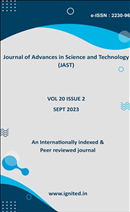An Overview of Characteristics and Application of Big Data
DOI:
https://doi.org/10.29070/qtsz4a47Keywords:
Data, Big data, Datamining, Clustering, HADOOPAbstract
Big data is huge volume, heterogeneous, appropriated data. Big data applications where data gathering has developed ceaselessly, it is costly to oversee, catch or concentrate and procedure data utilizing existing programming apparatuses. Clustering Technique for unstructured for big data is a primary errand of exploratory data investigation and data mining applications. This phenomenon, commonly referred to as Big Data, presents both opportunities and challenges across various domains. This paper provides a comprehensive overview of the characteristics and applications of Big Data. it delves into the characteristics of Big Data, including its volume, velocity, variety, veracity, and value. Understanding these characteristics is crucial for harnessing the full potential of Big Data analytics. the paper explores the diverse applications of Big Data across industries such as healthcare, finance, retail, manufacturing, and transportation.
Downloads
References
BABU, G.P. and MARTY, M.N. 1994. Clustering with evolution strategies Pattern Recognition, 27, 2,321-329.
Fayyad, U. Data Mining and Knowledge Discovery: Making Sense Out of IEEE Expert, v. 11, no. 5, pp. 20-25, October1996.
Guo, G, Neagu, D. (2005) Similarity-based Classifier Combination for Decision Making . Proc. Of IEEE International Conference on Systems, Man and Cybernetics, pp.176-181
Jyothi Bellary, BhargaviPeyakunta, SekharKonetigari “Hybrid Machine Learning Approach In Data Mining”, 2010 Second International Conference on Machine Learning and computing.
Oyelade, O. J, Oladipupo, O. O, Obagbuwa, I. C” Application of k- means Clustering algorithm for prediction of Students Academic Performance” (IJCSIS) International Journal of Computer Science and Information Security, Vol. 7,2010.
Varun Kumar and Nisha Rathee, ITM University, “Knowledge discovery from database Using an integration of clustering and classification”, International Journal of Advanced Computer Science and Applications, Vol. 2, No.3,March 2011.
McKinsey Global Institute (2011) Big Data: The next frontier for innovation, competition and productivity.
Chen, H., Chaing, R.H.L. and Storey, V.C. (2012) Business Intelligence and Analytics:FromBigDatatoBigImpact,MISQuarterly,36,4,pp.1165-1188.
Patel, A.B., Birla, M. and Nair, U. (2012) Addressing Big Data Problem Using HadoopandMapReduce,NIRMAUniversityConferenceonEngineering,pp.1-5.
Wu Yuntian, Shaanxi University of Science and Technology, “Based on Machine Learning of Data Mining to Further Explore”, 2012 International Conference on Machine Learning Banff, Canada.
NeelamadhabPadhy, Dr. Pragnyaban Mishra and Rasmita Panigrahi, “The Survey of Data Mining Applications And Feature Scope”, International Journal of Computer Science and Information Processing(CSIP).
Gandomi, Amir; Haider, Murtaza (April 2015). "Beyond the hype: Big data concepts, methods, and analytics". International Journal of Information Management. 35 (2): 137–144. doi:10.1016/j.ijinfomgt.2014.10.007. ISSN0268-4012.
Joshi, K., Khanduja, M., Kumar, R., Saxena, P., & Sharma, A. (2023). Big data-based clustering algorithm technique: A review analysis. Automation and Computation, 397-404.
Ahad M. A. & Biswas R. (2019) Handling Small Size Files in Hadoop: Challenges, Opportunities, and Review. In: Nayak J., Abraham A., Krishna B., Chandra Sekhar G., Das A. (eds) Soft Computing in Data Analytics. Advances in Intelligent Systems and Computing, vol 758. (pp. 653-663) Springer, Singapore.
Chen, M., Mao, S., Zhang, Y., & Leung, V. C. (2014). Big data: related technologies, challenges and future prospects (pp 1-89). Heidelberg: Springer.






